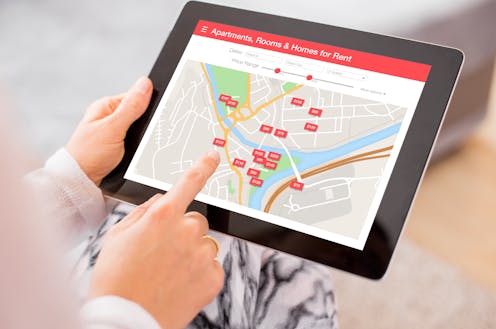Think short-stay rentals like Airbnb are out of control? Numbers are down, especially in our biggest cities
- Written by Thomas Sigler, Associate Professor of Human Geography, The University of Queensland

This article is part of The Conversation’s series examining the housing crisis. Read the other articles in the series here.
Further restrictions on short-term rental properties listed on platforms such as Airbnb and Stayz are on the table in Australia. Public pressure to ease the housing crisis is mounting. This makes quick-fix solutions to make housing more affordable increasingly attractive to governments.
But any policy should be evidence-based. So what can we learn from the latest data on short-term rentals? The findings of our analysis might surprise you:
- short-stay listings in Australia are down more than 15% on pre-pandemic numbers
- the number of active short-term rentals is a small fraction of the total number of dwellings in Australia and roughly equivalent to the number of new dwellings built each year
- there has been a shift in listings to regional areas, as major city numbers have dropped sharply.
It appears higher rents and property prices in our big cities could be making short-term rentals less attractive for owners and investors. Because housing market conditions and short-term rental impacts vary from place to place, there is no one-size-fits-all solution.
How have the numbers changed?
Short-term rental numbers have fallen significantly in Australia since December 2019. Numbers in Australia haven’t returned to pre-pandemic levels, despite a global rebound.
Our latest data show 278,788 unique short-term rentals were listed in Australia in December 2023. That’s well down from roughly 330,000 on the eve of the pandemic.
Of these listings, 191,123 (69%) were “active” rentals (available or booked at least one night a month). That’s down 13% from roughly 220,000 before the pandemic.
Of the active rentals in December 2023, 167,955 (88%) were “entire home” listings. These are rented without a host present.
The proportion of such listings has risen steadily since Airbnb emerged as a “sharing economy” phenomenon. However, many of these already existed as purpose-built, short-term accommodation. An example would be holiday lettings on Queensland’s Gold Coast.
All up, active unhosted short-term rentals comprise about 1.5% of Australia’s 11.1 million dwellings at any given time. This is roughly equivalent to the number of new dwellings built each year.
Read more: The government's Help to Buy scheme will help but it won't solve the housing crisis
How have locations shifted?
Our research team has observed significant shifts in the short-term property market since the eve of the pandemic.
The most obvious was the pandemic’s impact on the geography of short-term rentals.
As mobility restrictions and the loss of tourists affected cities the most, short-term tenants flocked to the regions. We saw a sharp drop in listings in many metropolitan areas. Short-term listings grew in “sea change” and “tree change” regions.
It’s unclear whether the balance of short-term rentals in major cities compared to regions will return to pre-pandemic levels. What we can see is that property owners have begun to respond to policy and price signals, especially in New South Wales.
Our research indicates the price difference between short-term and long-term rentals is highly localised. This suggests short-term listings are only lucrative for hosts under certain conditions. Location, size and property type all have an effect.
Both rents and dwelling prices are up by 48% nationwide since the pandemic began. The increases have been greatest on the urban fringes and in high-amenity coastal regions.
Logically, many dwellings in these areas have been “reconverted” to long-term rentals. High rents encourage owners to avoid the bother of having to clean properties and change the sheets and soap after each stay.
Read more: What is negative gearing and what is it doing to housing affordability?
Regulations must reflect local conditions
Much of the debate about short-term rentals has become polemic. Both communities and policymakers have been divided on the appropriate level of regulation and what the actual impacts would be.
Some blame short-term rentals for contributing to a lack of longer-term rental housing, or for local price increases. Others conclude short-term rental restrictions aren’t effective for resolving structural issues of housing supply and affordability. It’s also suggested restrictions may have unintended consequences, such as allowing hotels to charge more.
What is clear from our analysis is that different regions need different regulations.
New South Wales has the most stringent short-term rental regulation in Australia. The state has brought in several varieties of place-based caps, adapted to the needs of the local council area.
In Greater Sydney, unhosted short-term rentals can be occupied up to 180 days per year. (This limit excludes stays of 21 days or more.) In the Clarence Valley (North Coast) and Muswellbrook (Hunter Valley) council areas, the cap applies mainly in neighbourhoods characterised by low-density housing. In Byron Bay, a forthcoming measure to restrict certain areas to 60 days a year may be the final straw for some short-term rental hosts.
While such restrictions might ensure peace and quiet for residents of areas like Byron Bay’s exclusive hinterland estates, we are unconvinced at this stage that caps and levies significantly move the needle on housing supply or affordability in Australia. What’s more, such measures may reflect thinly veiled NIMBY efforts by residents of affluent suburbs to restrict access to their neighbourhoods by non-locals.
Read more: Will taxing short stays boost long-term rental supply? Other policies would achieve more
Authors: Thomas Sigler, Associate Professor of Human Geography, The University of Queensland





